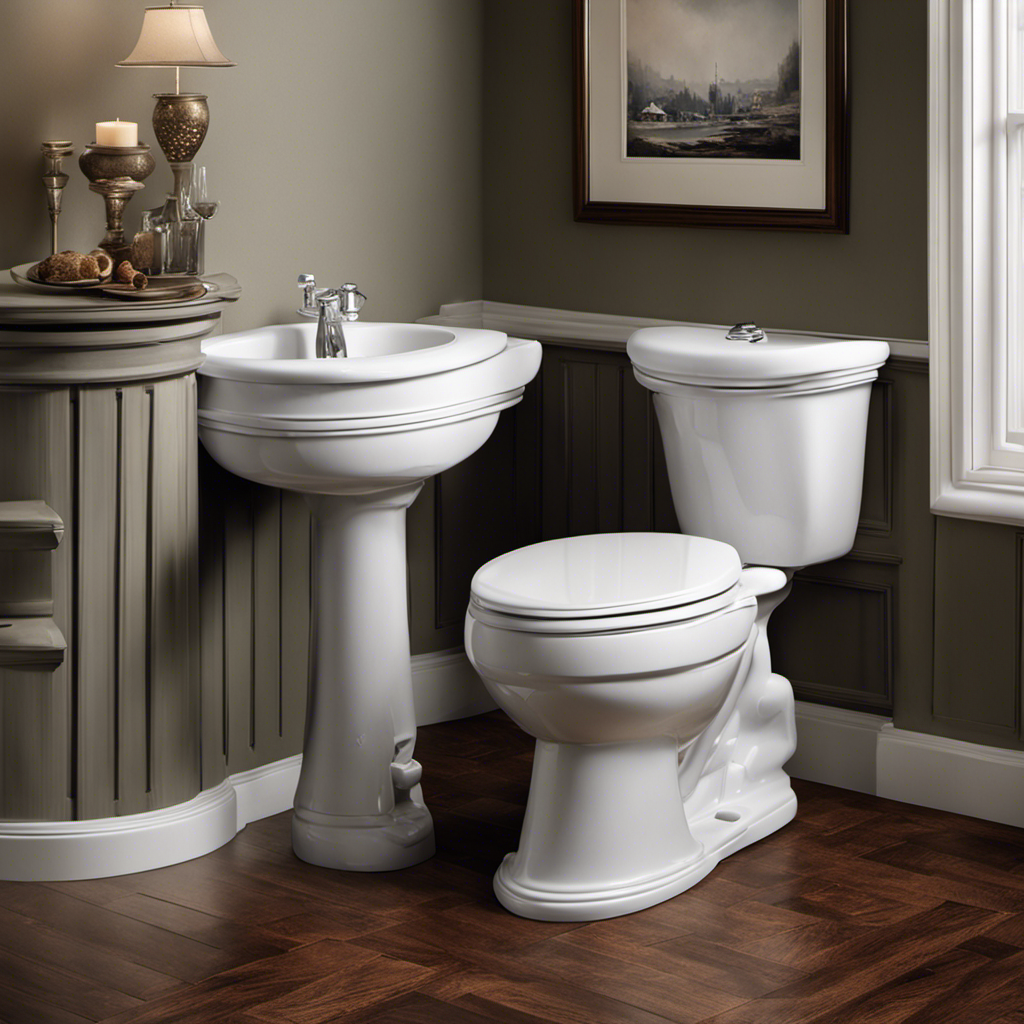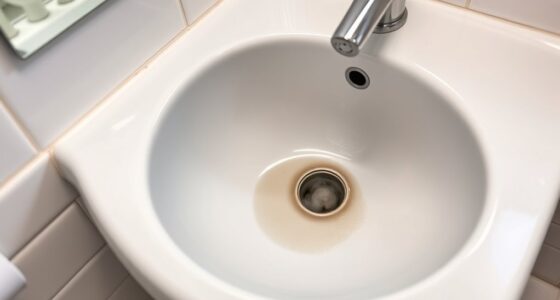Have you ever heard your toilet whistle after flushing? It’s like a high-pitched cry, haunting the silence of your bathroom. But fear not, for I am here to shed light on this mysterious phenomenon.
In this article, we will delve into the common causes of toilet whistling and guide you on how to identify and resolve the issue.
So, grab your wrench and prepare to conquer this unsettling symphony once and for all.
Key Takeaways
- Faulty fill valve is a common cause of toilet whistling after flushing.
- High water pressure can create turbulence in the pipes and lead to a whistling noise.
- Loose or faulty water supply valves can cause vibrations in the pipes and result in whistling.
- Regular maintenance, such as inspecting and adjusting water pressure, can help prevent toilet whistling in the future.
Common Causes of Toilet Whistling
One common cause of your toilet whistling after flushing is a faulty fill valve. The fill valve is responsible for controlling the water flow into the toilet tank. If it is not functioning properly, it can cause the water to rush through the valve, creating a high-pressure flow that results in a whistling noise.
To troubleshoot toilet whistling noises, it is important to first turn off the water supply to the toilet. Then, inspect the fill valve for any signs of damage or wear. If you notice any issues, such as a cracked or worn-out valve, it may be necessary to replace it.
Additionally, checking the water pressure and adjusting it if necessary can also help resolve the whistling problem. Remember, proper toilet whistle repair requires careful examination and replacement of the faulty components.
How to Identify the Source of the Whistling Noise
To identify the source of the whistling noise, you can start by checking the water supply valves. Here are some things to look out for:
- Loose or faulty valve: A loose or faulty valve can cause vibrations in the pipes, resulting in a whistling noise.
- Water pressure issues: High water pressure can create turbulence in the pipes, leading to a whistling sound.
- Partially closed valves: If the valves are not fully opened, it can cause water to flow through a smaller opening, creating a whistling noise.
- Obstructions in the pipes: Debris or mineral buildup in the pipes can disrupt the smooth flow of water and cause a whistling sound.
Understanding the physics behind toilet whistling can help troubleshoot the issue effectively. By addressing these potential causes, you can pinpoint the source of the whistling noise and move on to finding DIY solutions for resolving toilet whistling.
DIY Solutions for Resolving Toilet Whistling
By addressing the potential causes of toilet whistling, you can explore DIY solutions that may help resolve the issue. Toilet whistling can be a frustrating problem, but there are steps you can take to prevent and troubleshoot it. Here are some DIY solutions you can try:
| Potential Cause | DIY Solution |
|---|---|
| Loose fill valve | Tighten the fill valve nut |
| Water pressure | Install a pressure reducing valve |
| Partially closed water supply valve | Open the valve fully |
| Faulty ballcock assembly | Replace the ballcock assembly |
These solutions aim to address common causes of toilet whistling. However, if the problem persists or if you are unsure about performing these repairs yourself, it may be best to call a professional plumber. They have the expertise and tools to diagnose and fix the issue effectively. Transitioning to the next section, let’s discuss when it is appropriate to seek professional help.
When to Call a Professional Plumber
If you’re unsure about fixing the issue yourself, it’s best to call a professional plumber to diagnose and resolve the problem effectively.
When it comes to the signs of a damaged toilet valve or the importance of regular toilet maintenance, there are a few key things to keep in mind. Here are some important points to consider:
- Water leakage around the base of the toilet: This could indicate a damaged valve that needs to be replaced.
- Constant running water: If your toilet continues to run even after flushing, it could be a sign of a faulty valve.
- Weak flushing power: A damaged valve can result in reduced water flow, leading to weak flushing performance.
- Strange noises during flushing: Whistling or gurgling sounds may suggest a problem with the valve.
Regular toilet maintenance is crucial to prevent valve damage and ensure proper functionality. Don’t hesitate to contact a professional plumber who can accurately assess and fix any issues you may be experiencing.
Preventing Toilet Whistling in the Future
Regular maintenance can help prevent future instances of your toilet making whistling noises. It is important to understand that ongoing maintenance is crucial in keeping your toilet functioning properly.
One of the key factors in preventing toilet whistling is adjusting the water pressure. High water pressure can cause the toilet to make whistling noises when flushing. To adjust the water pressure, locate the water pressure regulator valve and turn it clockwise to decrease the pressure. It is recommended to consult a professional plumber if you are unsure about adjusting the water pressure yourself.
Additionally, regular inspections of the toilet’s components, such as the fill valve and flapper, can help identify any potential issues before they lead to whistling noises.
Frequently Asked Questions
Can Toilet Whistling Be a Sign of a More Serious Plumbing Issue?
Toilet whistling can signal a more serious plumbing problem. Causes include water pressure issues, a faulty fill valve or ballcock, or a worn-out washer. Prevent whistling by adjusting water pressure or replacing faulty parts.
Is It Normal for a Toilet to Whistle Occasionally After Flushing?
Occasionally, my toilet whistles after flushing. It can be a sign of a minor issue, like a faulty fill valve or a loose washer. To fix it, I’d check those components and replace if necessary.
Can a Faulty Toilet Valve Cause a Whistling Noise?
Yes, a faulty toilet valve can cause a whistling noise after flushing. It is one of the common toilet plumbing problems. To fix it, a toilet valve replacement may be necessary.
Are There Any Temporary Fixes for Toilet Whistling That I Can Try Before Calling a Plumber?
If your toilet is whistling after flushing, there are a few temporary fixes you can try before calling a plumber. From adjusting the fill valve to checking the water pressure, DIY solutions can save you time and money.
Can Hard Water Contribute to Toilet Whistling?
Yes, hard water can contribute to toilet whistling. The minerals in hard water can build up in the toilet’s mechanisms, causing vibrations and a whistling sound. Regular cleaning and using a water softener can prevent this issue.
Conclusion
In conclusion, identifying the source of toilet whistling can be a frustrating task, but with the right knowledge and tools, it can be resolved effectively.
By following the DIY solutions mentioned in this article, such as adjusting the fill valve or replacing the flapper, you can eliminate the annoying whistling noise.
However, if the issue persists or you’re unsure about the cause, it’s always best to call a professional plumber for expert assistance.
Remember, prevention is key, so regularly maintaining your toilet can help avoid future whistling problems.










